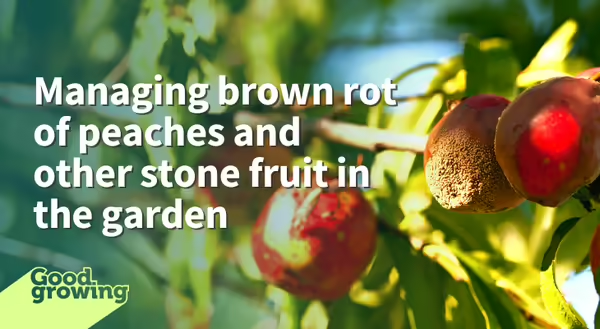
Have you ever gone out to pick a peach only to find they have a large brown, mushy spot? Or perhaps you've brought some peaches home from the farmers' market only to have developed these same spots a few days later. The likely culprit is brown rot.
Brown rot (Monilinia spp.) is one of the most common and troublesome diseases that affects peaches and other stone fruits like nectarines, plums, cherries, and apricots. While fruit infections may be the most noticeable problem, this fungus will also infect flower blossoms and shoots.
What does brown rot infection look like?
In the spring, flowers and shoots of stone fruits may become infected, particularly during warm, moist conditions. Infected flowers will wither, turn brown, and remain on the tree for an extended period of time. Eventually, the infection may travel into the shoots of the trees.
Infected shots will develop sunken brown cankers that may ooze gum. If a canker girdles an infected shoot, the leaves will turn dull green and eventually wither and die. The dead leaves will remain attached to the shoots for several weeks. Both flower and shoot infections can serve as a source of inoculum (the 'stuff' that causes infections) for fruit infections and for the following year.
While it is possible for green fruits to become infected, as they mature, they become more susceptible to brown rot infection (particularly starting 2-3 weeks before harvest). Brown rot begins as small, circular spots that will enlarge or coalesce. During warm, wet weather, fruits may completely rot within two to three days. Infected areas will produce tan to gray spore masse, giving the fruit a fuzzy appearance.
Diseased fruits will turn brown to black and become shriveled. Some fruit will drop to the ground, while others will remain attached to the tree. These fruits, called mummies, are a major source of inoculum come spring.
Managing brown rot
Good sanitation is probably the most important thing that can be done to manage brown rot. Pick up all dropped and rotted fruit promptly and destroy or discard them. Additionally, make sure to remove mummies from trees. During the dormant season, prune out any infected twigs and branches. Doing this will help reduce the amount of inoculum for the following season.
Pruning trees can also help reduce the amount of brown rot that develops. Opening up the canopy will help increase airflow through the canopy, allowing it to dry out faster. Thinning fruits so they won't touch when they are mature is also helpful. Learn more about printing at How to Prune Fruit Trees.
Managing insect pests and preventing bird damage can help reduce brown rot infections. Damage from insects and birds can provide openings in fruit for brown rot to enter.
Fungicides can also be used to manage brown rot. It's important to note that fungicides will not cure brown rot. Rather, they protect plant material from becoming infected. If you start spraying once you see brown rot, you likely won't get very good control.
Begin spraying trees when flower buds begin to turn pink and continue through the growing season. Select products that contain captan, myclobutanil, or propiconazole as their active ingredients. Make sure the product you choose is labeled for use on the type of tree you will be spraying. Make sure to read and follow all label directions and pay attention to pre-harvest intervals (the amount of time you need to wait to harvest a crop after a pesticide is applied).
For more information on brown rot, check out Unversity of Illinois' Report on Plant Disease 802 - Brown Rot of Stone Fruits.
Good Growing tip of the week: Be careful when harvesting fruit and store them in a cool location. Injured and damaged fruit is more likely to develop brown rot during storage.
Signup for our emails! Want to get notified when new Good Growing posts are available? SIGN ME UP
MEET THE AUTHOR
Ken Johnson is a Horticulture Educator with University of Illinois Extension, serving Calhoun, Cass, Greene, Morgan, and Scott counties since 2013. Ken provides horticulture programming with an emphasis on fruit and vegetable production, pest management, and beneficial insects. Through his programming, he aims to increase backyard food production and foster a greater appreciation of insects.